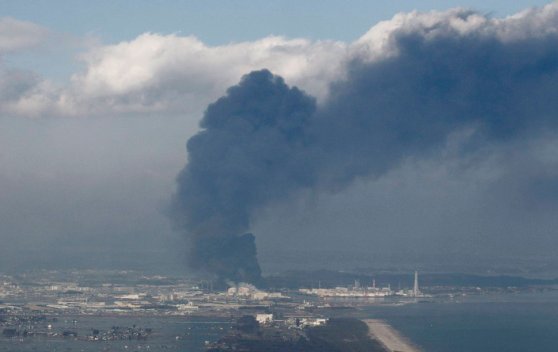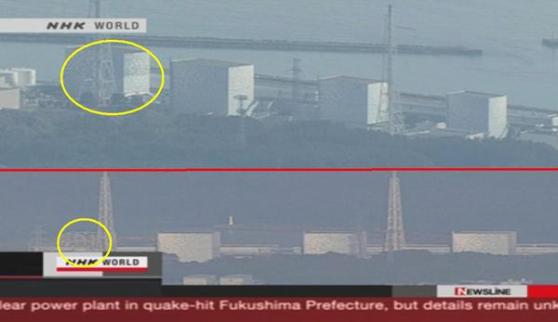The worst, at least the worst I can imagine, has happened. After some 22 hours of trying to regain control of the overheating Fukushima No 1 nuclear reactor power station in Futuba, there has been an uncontrolled explosion and reports of injuries.
Background on the Japanese earthquake and tsunamis here. After the incidents, the regular electrical grid went down and the backup power at the Fukushima plant failed, resulting in an inability to pump coolant around the heated nuclear material, a function which is absolutely essential to safety. Since then, temperatures have risen at the plant even as intrepid workers have struggled to pump in cooling water via other means. Not long ago, they lost the battle.
There are reports of at least four workers injured; none of the injuries appears life-threatening, according to sources.
From the Guardian earlier today, prior to the expolosion:
Japanese media said officials had detected caesium, one of the elements released when overheating causes core damage, around the reactor at Fukushima No 1 plant in Futuba, 150 miles north of Tokyo.
The Tokyo Electric Power Company said it did not believe a meltdown was underway but Ryohei Shiomi, an official with Japan’s nuclear safety commission, said that it was possible.
Experts and authorities played down the dangers of a Chernobyl-style disaster, saying they believed a partial meltdown was controllable. The government urged people to remain calm.
Officials had earlier evacuated 20,000 residents living within 10km on the plant on the orders of the prime minister, Naoto Kan, who had inspected it via helicopter. Experts told Associated Press that the risk area was 6km….
Earlier in the day a Japanese nuclear safety panel said radiation levels were 1,000 times higher than normal in a control room and eight times normal just outside the plant. Workers were frequently changing shifts.
The Tokyo Electric Power Company has also reported problems with a second reactor at the plant and declared an emergency at the Fukushima No 2 plant.
And now, from the BBC:
Japan’s NHK TV showed before and after pictures of the plant. They appeared to show that the outer structure of one of four buildings at the plant had collapsed after the explosion.
The Tokyo Electric Power Co, the plant’s operator, said several workers had been injured.
Cooling systems inside several reactors at both the Fukushima plants stopped working after Friday’s earthquake cut the power supply.
Japan’s nuclear agency said on Saturday that radioactive caesium and iodine had been detected near the number one reactor of the Fukushima 1 plant.
The agency said this may indicate that containers of uranium fuel inside the reactor may have begun melting.
Air has been released from several of the reactors at both plants in an effort to relieve the huge amount of pressure building up inside.
Mr Kan said the amount of radiation released was “tiny”.
Thousands of people have been ordered to evacuate the area near the plants. BBC correspondent Nick Ravenscroft said police stopped him 60km from the Fukushima 1 plant.
Analysts say a meltdown would not necessarily lead to a major disaster because light-water reactors would not explode even if they overheated.
UPDATE: here is more scientific background on the nature of the risk, via Dave MacDonald.
Nuclear experts across countries have warned that the situation could become grave if the fault at the Fukushima plant was not fixed soon. Cham Dallas, a professor of disaster management at the University of Georgia, has told CNN that the plants were likely to get “both thermally hot and radioactively hot” since the reactors had to be shut down.
Another nuclear physicist Dr Walt Patterson told The Sun: “It is the sort of thing that nuclear engineers have nightmares about…If the core is uncovered, then those rods at the top may get hot enough to melt themselves.”
Which would be what you call a “worst-case scenario.”
My faint hope is, there’s nothing more to report by tomorrow morning. My somewhat less faint hope is that eventually this becomes a coastal version of the Land of the Wolves.
UPDATE:
UPDATE: Bloomberg has the best roundup of information at this point. It was a hydrogen leak, not a steam explosion, which caused the event.
Winds in the area of the Fukushima plant are blowing at less than 18 kilometers per hour mostly in an offshore direction, according to a 4 p.m. update from the Japan Meteorological Agency.
The government earlier today widened the evacuation zone around the reactor to 10 kilometers from 3 kilometers, affecting thousands of people. The evacuation zone will be maintained at 10 kilometers from Dai-Ni plant and will be extended to 20 kilometers from Dai-Ichi plant, said Toshihiro Murakami, spokesman for the Fukushima prefecture government.
“When the pressure starts building up, the emergency procedure is to start venting,” Dave Lochbaum, director of the nuclear safety project at the Union for Concerned Scientists, said in a telephone interview. “They’ve essentially entered a beat the clock game. As long as there is no fuel damage, there will be radioactivity, but it will be very low.”
The plant’s operators need to connect to the electricity grid, fix emergency diesel generators or bring in more batteries to power a backup system that pumps the water needed to cool the reactor, said Lochbaum, a nuclear engineer who has worked at nuclear power plants for 17 years.
Nuclear Meltdown
The air cooling system in the containment building probably failed due to the power loss, allowing pressure to increase inside, Lochbaum said.
Lack of adequate cooling for a reactor may cause a core meltdown, the most dangerous kind of nuclear power accident, according to the U.S. Nuclear Regulatory Commission.
A meltdown could potentially breach a reactor’s containment building, releasing massive amounts of radiation, according to information on the agency’s website. The 1979 accident at the Three Mile Island reactor in Pennsylvania resulted in a partial meltdown, without a breach in the containment building, according to the commission.
Related articles
- Japan Nuclear Plant Explosion,Nuclear Plant Meltdown Fears Confirmed (socialdiets.wordpress.com)
- Fukushima Power Plant Explosion Reported: Did Reactor Explode? (nowpublic.com)
- Cooling issue at Tepco plant in Fukushima (marketwatch.com)
- The Great Sendai Quake – Fukushima nuclear plants status is critical (ktwop.wordpress.com)
- URGENT: Abnormality reported at Fukushima nuclear plant | Kyodo News (shortformblog.tumblr.com)






Pingback: VIDEO- Explosion at Japan Fukushima Number One Nuclear reactor, Uranium fuel may be melting at reactor | Iron Mill News Service
Thanks raincoaster for all of these updates, my computer couldn’t load half of what I was trying to read and check on.
It exploded?!!!! The last time I had the news on they were reporting a big black cloud that they thought was a building on fire but couldn’t get any closer to investigate because of the tsunami warnings that were still going on. I guess this was that big black cloud.
To me this is the worst I could’ve imagined even after that tsunami.
It’s not as bad as it appears. Look at that radiation level in the tweet I posted: in Chernobyl, people were getting a lifetime’s worth of radiation in 90 seconds. This is nowhere near that level.
The real danger is that they won’t be able to cool the core and it will continue to leak radiation Chernobyl style until doomsday.
Correction: it was a hydrogen explosion.
http://www.bloomberg.com/news/2011-03-12/explosion-destroys-walls-of-japan-reactor-building-nhk-reports.html
Glad you deleted that post about the Gawker comment, rain. Whoever made it has idea.
It’s interesting how the media is reporting this, almost willing the disaster to catastrophic levels. German media is conveniently neglecting to mention that radiation levels are dropping and the situation is not as bad as previously thought.
Ian, when the reactor blew up, I just didn’t have the heart to leave it up. I’m pretty brassy, but it just didn’t feel right.
Irish Berliner, the reports I’m hearing out of Japan and Indonesia say the levels are rising. I am not trying to will anything to happen, but the “oh it’s all good, it’s copacetic, let’s all have a picnic on the reactor pile” chorus seems to me an engineered campaign to prevent panic. Which may be admirable as a government goal, but I don’t think it is honest. I want to know what’s actually going on.
Pingback: TOKYO NEON LIGHTS | 11MAR11, A DATE TO REMEMBER
So you are human raincoaster ;)
I have to agree with you there. I know that everything right now is a mess, I know that death has happened, I know children won’t feel secure for a long time but is it really honest to play a political stategy when people could be getting exposed to such a thing?
Pingback: Japan’s Meltdown « Dregs of the Future
It’s ongoing. Why do politicians think covering things up is the right thing to do? Nobody’s going to blame them for an earthquake.
News are also circulating in the Philippines that radiation will most likely hit the country, mostly caused by Japan winds being blown off to the country. Any news about that? The people are somewhat scared and we are all hoping and crossing our fingers that this really is just a hoax.
http://randomthoughtsinabox.blogspot.com/2011/03/fukushima-nuclear-power-plant.html
Well unless you’re the President of the USA then yes the earthquake is your fault.
Actually, the way the Japanese government and the media is handling this is actually normal in Japan and perfectly acceptable. The Japanese are very careful that they don’t assign incorrect blame to something or someone because of sensationalistic news coverage, like that you see in the US. They are also giving the facts as they happen and warning people who need to be warned to evacuate.
I live in Asia, and every Asian I know believes the Japanese government is handling this admirably. I’d take this type of news handling any day over the American “the world is ending and who should be blame” mentality. It’s also a big reason why the Japanese will solve this problem, recover from the earthquake and move on. Unlike New Orleans which, years later, still looks like a bomb hit it in many areas of the country.
Americans could learn something from the Japanese, IMO but, taking the US mentality into consideration, unfortunately that’s highly unlikely :(
Pingback: Japan’s Meltdown– « Pragmatic Witness
They are NOT giving the facts as they happen. They have knowingly suppressed several key facts and thus exposed their people to actual physical danger. You may prefer not to be informed of approaching doom, but when that doom can be avoided by a timely evacuation facilitated by realtime information, and the government does not provide it, that government may be said to have failed in the most profound sense.
Normally we’re all for taking swings at the US on this blog, but your attack comes as a complete non-sequitur. That the Japanese government sat on information and exposed people to fatal danger has nothing whatsoever to do with the style in which the American news agencies covered this. If it makes you feel better to lash out, well, I understand that. I even understand how illogical it is.
It’s a very serious time for Japan. They’ve even made a carton to explain it to young kids “Nuclear Reactor Boy has a tummy ache”
http://www.japansugoi.com/wordpress/cartoon-explaining-the-fukushima-nuclear-reactor-problem-to-kids/
Pingback: Fukushima Explosion and Aftermath « raincoaster | Fukushima-nuclear.com
Pingback: HAARP – The World’s Sexiest Energy Weapon | R3zn8D's (R)Evolutionary Blog
Pingback: Fukushima explosion | SZUKAJ
Pingback: Geoengineering of the Earth’s Atmosphere–here’s the links | Dregs of the Future